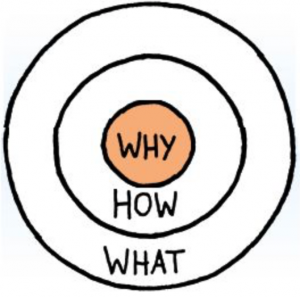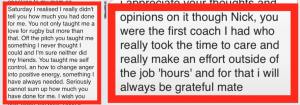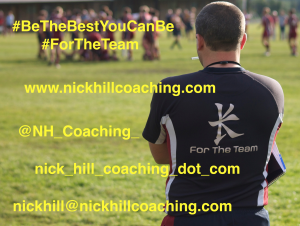A key starting point I think is to make coaches more aware as to WHY they should use a Player-centred Coaching approach rather than a Coach-centred one…
If coaches understand the WHY then they will be more informed and more inclined to make a Paradigm Shift in their coaching approach if they are Coach-centred…
“As coaches learn, they tend to change their attitudes and values in accordance with athletes’ needs. Because these changes will affect a coaching philosophy, reviewing the philosophy regularly and altering it to fit with each coach’s experience are important features of the process of developing a philosophy” p.30 Athlete-centred Coaching: Developing Decision Makers, Lynn Kidman, 2nd edition, 2010
“A philosophy is based on ideas formed from experiences. These experiences stem from influential teachers, coaches or mentors who have had a positive or negative effect on aspects of your life.” p.31 Athlete-centred Coaching: Developing Decision Makers, Lynn Kidman, 2nd edition, 2010
If coaches can see the positive outcomes of using a Player-centred approach and the negative outcomes of using a Coach-centred approach, these observations/findings will help to empower them to make their own decisions as to what type of coach they would like to be to provide the best possible culture and environment for the players they coach.
“…most participants come to the sport of their own choosing…generally they want to be there. By the same token, participants usually leave an experience of their own free will…if the experience is not to their satisfaction, athletes will leave and find something else that is…athletes are leaving sport experiences in masses because of their unpleasant experiences, or an experience that does not meet their needs (Roberts and Treasure, 1995).” p.11 Athlete-centred Coaching: Developing Decision Makers, Lynn Kidman, 2nd edition, 2010
Here is what some of the research says with regards to a Player-centred approach…
- Develops positive personal and social development;
- Less experienced/skilled players can make very valuable contributions;
- Players take more responsibility for their learning;
- The environment is more engaging;
- It promotes creativity, provides problem solving, and challenges players;
- Encourages a holistic approach;
- Develops critical thinking;
- Promotes high levels of participation and enjoyment for participation;
- Caters for varying abilities;
- Increases motivation and enjoyment.
Here is what some of the key books say…
- You need to provide child players with a positive sporting experience so that they continue to participate in sport;
- The secret of their success is in the ability to pull a group of individuals together to create an environment where athletes share in the direction and responsibility of the team;
- …athletes take ownership of their learning, thus increasing their opportunities and strengthening their abilities to retain important skills and ideas;
- Children have become so accustomed to being directed, supervised and told how, where and what to play that player decision making in sport has disappeared from the landscape;
- …athletes gain and take ownership of knowledge, development and decision making that will help them to maximise their performance and their enjoyment;
- …athletes develop understanding and learn more effectively when they are involved in solving problems and have ownership and responsibility for their learning;
- …practice can be made more meaningful, purposeful, just and enjoyable…;
- …creates conditions for implicit learning and, in doing so, generates deeper learning and more transportable learning outcomes (Brooker and About 2001; Hadfield 2005; Light et al. 2014c);
- …the coach steps off centre stage as the distributor of knowledge to become a facilitator of learning…;
- …provides positive learning experiences that foster a love of learning, imagination and problem-solving skills, and that develop active, inquisitive learners instead of passive receivers of knowledge.
“If leaders merely present knowledge (sometimes quite forcefully) to those who are ‘non-expert’ and make decisions for them, the athletes become disempowered. In other words, if athletes’ needs do not influence their learning experiences, learning is minimal. The knowledge, understanding, skill and decision-making ability that athletes learn and apply can make the difference between performance success and failure as well as developing a long-term or lifelong attachment to movement.” p.12 Athlete-centred Coaching: Developing Decision Makers, Lynn Kidman, 2nd edition, 2010
Here are some of my observations of the two different approaches…
Through the numerous cultures and environments around the world that I have been fortunate to work in… coach in… observe in… and play in… I’ll share with you some of the numerous and varied observations that I have seen and felt with regards to each approach over the years…
| Factor | Coach-centred | Player-centred |
| Team Culture: Standards & Expectations | Never done or coach set and coach enforced | Players set and self-police/enforce |
| Games in training | At the end…
Always full contact and no teaching/learning going on |
Start and end with a game…
Conditioned to work on Games Understanding and Decision Making |
| Asking questions… | Never | All the time |
| Telling | All the time | Rarely |
| Guided Discovery | Never | Most of the time |
| Player Enjoyment | Less so | Very high |
| Participation Numbers | Only the A team | Lots and lots… |
| Attendance at training | Inconsistent week-to-week
Lots of players only when there are “important” matches Gradual decrease as the season goes on |
Consistent across the whole season
Gradual increase as the season goes on |
| Player energy/enthusiasm | Pretty poor | Very high |
| Player punctuality | 10 minutes late | 10 minutes early |
| Injuries | Lots and plenty of major/serious ones requiring surgery | Not very many and hardly any major/serious ones |
| Player tantrums/frustrations | Frequent/Plenty | Hardly ever |
| Team Spirit | Disjointed, Cliqués | Very positive |
| Potential players | Never come training
Choose others sports/activities |
Come training after encouragement and stay training |
| Lectures | Lots and lots | Very few |
| Lines | Lots and lots | Never |
| Coach on the sidelines in matches | Barking orders/instructions all the time | Coach stood there just watching/observing and making notes in their notebook |
| Injured players on match days | Go off and do their own thing | Be waterboys
Go behind the video camera |
| Drills | All the time and unopposed | Purposeful, Deliberate and Pressurised Practices with opposition |
| Team Togetherness | Bunch of individuals | One Team |
| Game Speed at training | Below Game Speed | At or Above Game Speed |
| Team Selection | The “best”/most talented players picked all the time regardless of character, attitude, attendance at training and form | The best people picked all the time with the right character, best attitude & attendance at training |
| Squad “beastings” | All the time after a loss | During pre-season to challenge/test the squad mentally to create a reference point for later in the season when needed |
| Focus | Short-term winning | Long-term development |
| Empowerment | Disempowering | Empowering |
Coach-centred…
Players left out of training whilst others are playing…
How much learning is going on while they are standing/sat on the floor doing nothing…?
What is this doing to their intrinsic motivation…?
Is this going to make them to want to come again…?!
What could they be doing instead…?!
Why should these players be receiving a different experience than their peers…?!
Giving lectures… Barking orders…
Can shouting from the sideline really make any difference to a player when that player is fully immersed in the game…?
How is the player going to learn if he is told what to do all the time…?
Are players really listening and taking on board the information coaches are telling them straight after a game…?!
Why do parents insist on being on the actual playing service whilst their kids are playing sport…?!
Major injuries…
Why do people insist on continuously playing players numerous times per week when their bodies are not physically prepared to meet these demands…?
Why are parents making their players play too many matches too young…?!
Why are coaches under-preparing their players for the demands of the real game…?
Why are we still seeing static stretching being done in the 4 corners of the field as their warm-up in 2018…?!
Why aren’t coaches carrying out a comprehensive Athletic Development warm-up prior to all training sessions and matches to prepare their players better for what they are about to do…?!
Why are we seeing a pandemic of ACL knee injuries around the world at all levels of sport…?!
Why are we seeing so many shoulder injuries…?!
Why are we seeing so many head injuries (excluding Concussions)…?!
Why are we seeing so many “growing pains” knee injuries around the world…?!
Player-centred…
The impact you have on lives…
The messages you receive later on…
The relationships you create and the friendships you build…
Then the impact you have 12 years later…
Feel free to get in touch with me with questions you’d like answering or a particular topic you’d like to know more about…
I plan to write a weekly article every Sunday evening…
If I don’t receive any recommendations during each week then I’ll pick a topic or an experience to write about to share with you that I hope will help you on your Coaching Journey as one person teachers, two people learn…










